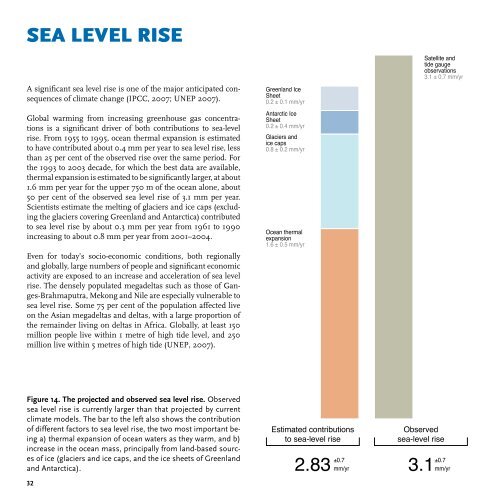In Dead Water: Merging of climate change with - UNEP
In Dead Water: Merging of climate change with - UNEP
In Dead Water: Merging of climate change with - UNEP
You also want an ePaper? Increase the reach of your titles
YUMPU automatically turns print PDFs into web optimized ePapers that Google loves.
SEA LEVEL RISE<br />
A significant sea level rise is one <strong>of</strong> the major anticipated consequences<br />
<strong>of</strong> <strong>climate</strong> <strong>change</strong> (IPCC, 2007; <strong>UNEP</strong> 2007).<br />
Global warming from increasing greenhouse gas concentrations<br />
is a significant driver <strong>of</strong> both contributions to sea-level<br />
rise. From 1955 to 1995, ocean thermal expansion is estimated<br />
to have contributed about 0.4 mm per year to sea level rise, less<br />
than 25 per cent <strong>of</strong> the observed rise over the same period. For<br />
the 1993 to 2003 decade, for which the best data are available,<br />
thermal expansion is estimated to be significantly larger, at about<br />
1.6 mm per year for the upper 750 m <strong>of</strong> the ocean alone, about<br />
50 per cent <strong>of</strong> the observed sea level rise <strong>of</strong> 3.1 mm per year.<br />
Scientists estimate the melting <strong>of</strong> glaciers and ice caps (exclud-<br />
ing the glaciers covering Greenland and Antarctica) contributed<br />
to sea level rise by about 0.3 mm per year from 1961 to 1990<br />
increasing to about 0.8 mm per year from 2001–2004.<br />
CM<br />
Even for today’s socio-economic conditions, both regionally<br />
MY<br />
and globally, large numbers <strong>of</strong> people and significant economic<br />
activity are exposed to an increase and acceleration <strong>of</strong> sea level CY<br />
rise. The densely populated megadeltas such as those <strong>of</strong> Gan-<br />
CMY<br />
ges-Brahmaputra, Mekong and Nile are especially vulnerable to<br />
sea level rise. Some 75 per cent <strong>of</strong> the population affected live K<br />
on the Asian megadeltas and deltas, <strong>with</strong> a large proportion <strong>of</strong><br />
the remainder living on deltas in Africa. Globally, at least 150<br />
million people live <strong>with</strong>in 1 metre <strong>of</strong> high tide level, and 250<br />
million live <strong>with</strong>in 5 metres <strong>of</strong> high tide (<strong>UNEP</strong>, 2007).<br />
Figure 14. The projected and observed sea level rise. Observed<br />
sea level rise is currently larger than that projected by current<br />
<strong>climate</strong> models. The bar to the left also shows the contribution<br />
<strong>of</strong> different factors to sea level rise, the two most important being<br />
a) thermal expansion <strong>of</strong> ocean waters as they warm, and b)<br />
increase in the ocean mass, principally from land-based sources<br />
<strong>of</strong> ice (glaciers and ice caps, and the ice sheets <strong>of</strong> Greenland<br />
and Antarctica).<br />
C<br />
M<br />
Y<br />
Greenland Ice<br />
Sheet<br />
0.2 ± 0.1 mm/yr<br />
Antarctic Ice<br />
Sheet<br />
0.2 ± 0.4 mm/yr<br />
Glaciers and<br />
ice caps<br />
0.8 ± 0.2 mm/yr<br />
Ocean thermal<br />
expansion<br />
1.6 ± 0.5 mm/yr<br />
6c_sealevelcontributions.pdf 2007-04-26 15:12:09<br />
Estimated contributions<br />
to sea-level rise<br />
±0.7<br />
2.83 mm/yr 3.1<br />
Satellite and<br />
tide gauge<br />
observations<br />
3.1 ± 0.7 mm/yr<br />
Observed<br />
sea-level rise<br />
±0.7<br />
mm/yr

















